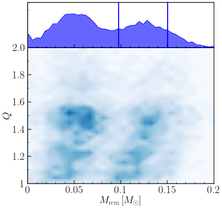Paper: Constraining the Properties of the Progenitor of GW170817
This post summarizes a paper about how well one can distinguish whether the progenitor of the GW170817 event was a binary neutron star or a neutron-star black-hole binary.
Paper Highlighted
- T. Hinderer, S. Nissanke, F. Foucart, K. Hotokezaka, T. Vincent, M. Kasliwal, P. Schmidt, A. R. Williamson, D. A. Nichols, M. Duez, L. E. Kidder, H. P. Pfeiffer, and M. A. Scheel. “Discerning the binary neutron star or neutron star-black hole nature of GW170817 with Gravitational Wave and Electromagnetic Measurements.” Phys. Rev. D 100, 063021 (2019), arXiv:1808.03836.
Summary of the Paper
 The gravitational-wave (GW) event GW170817 was followed by electromagnetic (EM) observations of the system over a broad range of the EM spectrum from gamma rays to radio waves.
The GWs were consistent with the merger of two objects with masses typical of neutron stars, and the EM observations were those expected if at least one of the objects were a neutron star.
Thus, while a binary neutron star is the favored progenitor for the system, it has not been definitively shown that this is the only possible binary progenitor.
In this paper, we investigated whether a binary composed of a low mass black hole and a neutron star could explain the observed GW and EM signals.
Using new numerical relativity simulations of black-hole neutron-star binaries, we showed that both the GWs and kilonova emission from an unequal-mass binary could be consistent with the observed emission from GW170817.
When we combined information from the GW measurements with predictions of the remaining mass around a black hole following its merger with a neutron star, we could put conservative constraints on the regions of parameter space in which the system could have been a black-hole neutron-star binary.
Surprisingly, there was still a substantial region that could be consistent with a neutron-star black-hole system.
The gravitational-wave (GW) event GW170817 was followed by electromagnetic (EM) observations of the system over a broad range of the EM spectrum from gamma rays to radio waves.
The GWs were consistent with the merger of two objects with masses typical of neutron stars, and the EM observations were those expected if at least one of the objects were a neutron star.
Thus, while a binary neutron star is the favored progenitor for the system, it has not been definitively shown that this is the only possible binary progenitor.
In this paper, we investigated whether a binary composed of a low mass black hole and a neutron star could explain the observed GW and EM signals.
Using new numerical relativity simulations of black-hole neutron-star binaries, we showed that both the GWs and kilonova emission from an unequal-mass binary could be consistent with the observed emission from GW170817.
When we combined information from the GW measurements with predictions of the remaining mass around a black hole following its merger with a neutron star, we could put conservative constraints on the regions of parameter space in which the system could have been a black-hole neutron-star binary.
Surprisingly, there was still a substantial region that could be consistent with a neutron-star black-hole system.
